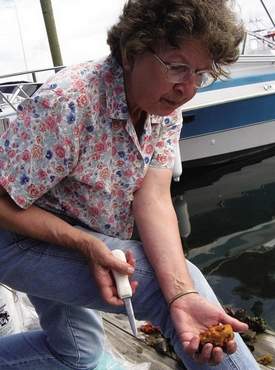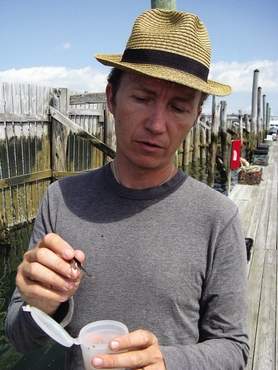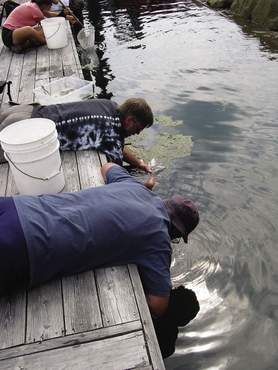Marine Researchers Testing Seacoast Waters
By Dave Choate
Hampton Union, Tuesday, August 3, 2010
[The following article is courtesy of the Hampton Union and Seacoast Online.]

[Dave Choate Photo]
HAMPTON -- Invaders from foreign seas are here -- and they're not going away.
Invasive species of plants and animals can have a profound effect on marine and freshwater environments. The organisms can crowd out existing species in competition for food and sun, sometimes tilting the balance of a body of water, damaging fish stocks or, as is the case with the notoriously ubiquitous zebra mussel, clog drain pipes.
A team of about 20 researchers and graduate students from around New England, the United States and even the Netherlands have hit spots along the Eastern Seaboard from New York City to the Gulf of Maine for an hour each, scouring docks and tidal pools for invasive species. It's a group Dave Kellam of the Piscataqua Regional Estuarine Partnership jokingly calls the "Superfriends of marine invasive species," but one that PREP is actively involved with because of the critical nature of their work.
"It is one of our action plans," Kellam said. "We don't have it as high a priority as the water quality issues ... in part because the control methods (for existing invading species) aren't really there. It's on our radar screen."
Dr. James Carlton, director of the Williams-Mystic Program between Williams College and Mystic Seaport in Connecticut, said the goal is to conduct an assessment of marine biodiversity. He and fellow researchers at Hampton Marina brought up organisms to look at or take to the University of New Hampshire's Jackson Marine Laboratory for further study. Carlton said the goals are to establish a baseline for species present, identify any new species and see if existing invasive species increased their range due to increasing water temperatures fueled by climate change.
Those varying factors, coupled with salinity levels in water, have made for different species in areas, including Portsmouth, Rye and Hampton, according to Walt Lambert of Framingham State College in Massachusetts.
Researchers' top concern is the potential recreational and economic impact, especially from species that foul boats, plug pipes and out-compete existing animals for food. Carlton acknowledged entrenched species cannot be eliminated, but said early detection can help prevent other invasive species. He cited the green crab, which is so common in New England one might not suspect it was originally imported to the country from Europe and quickly took root in the 1890s.
"A lot of what we're doing is called early detection, rapid response," he said, adding "there's a plethora of vectors (by which new species can arrive in the U.S.)."
Fighting the problem requires increased awareness and educational outreach. Awareness, he said, is especially important for those shipping goods abroad who may inadvertently transport species with their cargo. Carlton said regulations would be helpful before a species comes along that decimates ecosystems in the United States.
Researchers found no new species on Thursday. In Hampton, though, they found a known invasive species of "skeleton shrimp" that are not true shrimp but amphipods that Niels Hobbs of Rhode Island said have impacted existing New England species.
Carlton said he was pleased to not find new invasive species, as that means previously unidentified or undiscovered species either aren't present or have not established themselves in the area. "When we don't find new specimens that will make the front page, that's good news," he said.
One existing species, present since the 1970s and originating in Japan, is a mostly orange variety of the tunicate or "sea squirt," nicknamed for how they eject water when handled. Gretchen Lambert of the University of Washington said the creature is a colonial animal, similar in a superficial way to coral, and characterized it as a "very aggressive, fast-growing" species that holds off predators through the use of a naturally produced toxic by-product.
Judy Pederson of the Massachusetts Institute of Technology, a point person for the project since it began in 2000, said the studies are typically conducted every three years. The group was also in Rye and Durham last Thursday, and were scheduled to study organisms at Jackson Lab through Saturday, Lambert said.

[Dave Choate Photo]

[Dave Choate Photo]
At a glance
Tips to avoid introducing invasive species:
* Discard live seafood in the trash, not in the water.
* Discard shells in the trash or the garden, not in the water.
* Keep boats, particularly hulls, clean and free of species such as algaes.
* Never dump aquarium water or aquatic pets into any body of water.
* Report sightings of new or unusual species to state officials.
-- Massachusetts Institute of Technology Sea Grant College Program
